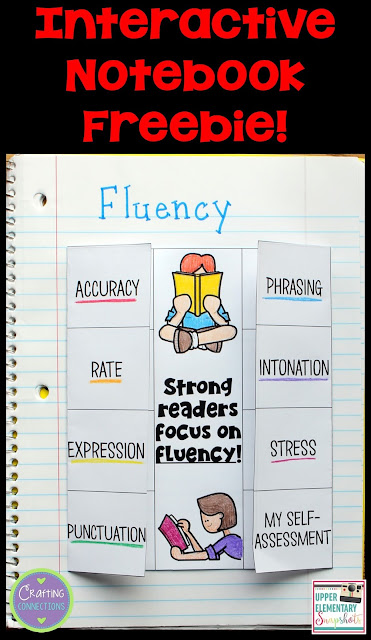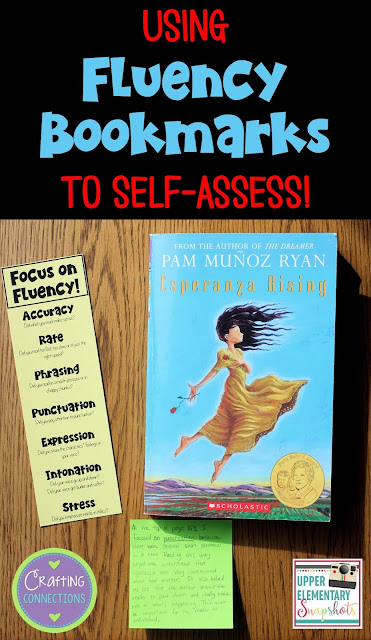Ask your students what it means to be a fluent reader.
You’re likely to get a wide variety of answers. Chances are good that your
students will provide correct answers… partially correct, anyway. As we teachers know, when it comes
down to it, reading fluency involves multiple components.
ACCURACY
First, there’s accuracy. It is easy to recognize how
accuracy is related to reading comprehension. If students are failing to read
several words accurately, the meaning of the text will be changed or lost.
Knowing your students’ accuracy rate is critical because it will help you
provide the correct reading materials for them.
You can identify a student’s accuracy rate by finding the
percentage of words in a text read correctly. A fellow reading teacher once
shared this simple recording sheet with me, and explained how she used it to
track her students’ accuracy. As you can see, each recording sheet contains a section with 100 small boxes. Ask a student to read aloud to you. Draw a tick in a box for each word
your student reads correctly. When your student misreads a word, draw a line
across the middle of the box. Above the line, write the word they said. Below
the line, write the word that was printed in the text. When you run out of
boxes, you have hit 100 words, and you can easily calculate your student’s accuracy percentage.
RATE
Another significant element to consider is rate. Is your student reading too fast? Too slow? I
have found that many students think that the faster you read, the more fluent you
are. We teachers know that this is not the case. When I find a student who
reads too fast, I will say, “Whoa! My brain just cannot process what is being
read when you read that fast! Would you please start over, and this time read a
bit more slowly so that I can process what you’re reading to me?” I’ve also
done a comparison reading with students: I read aloud a nonfiction passage
super-fast and then ask them a few questions about what I read to them. When
they are not able to answer my questions, I read at an appropriate rate. After
they are able to answer the same questions I asked before, we discuss the
connection between reading rate and comprehension.
When I work with students who read too slow, I find texts at
their independent reading level and have them read the same text multiple
times, increasing the speed with each reading.
PROSODY
Prosody is reading aloud with expression, smoothness, and
stress. Prosodic readers pay attention to punctuation and italics. It is evident that they are comprehending the
text because they know how to match their tone and pitch to what is being read.
I tell my students that when a prosodic reader is reading, it is fun to listen to
him or her.
TEACHING FLUENCY TIPS TO UPPER ELEMENTARY STUDENTS
I have used several materials to teach fluency tips to upper
elementary students. First, I use the posters and the interactive
notebook foldable shown below. After I have introduced the posters, students create the
foldable to glue into their notebooks. Behind each flap, they write their own notes
to help them remember how each word is related to fluency. (Click on either of the images to download these free printables.)
I also have bookmarks for students use as they are reading. Occasionally I hand students a sticky note, and ask them to jot down a note explaining how reading fluently helped them comprehend the text. I expect them to address at least one of the fluency components in their explanation.
FUN FLUENCY-BUILDING ACTIVITIES
I LOVE helping students work toward becoming fluent readers! My favorite method is to use partner
plays. These are great reading center options. Students can read the script with a partner while the teacher is working with small guided reading groups. These scripts require exactly two readers, allowing students plenty of opportunities to read. I recently added a comprehension worksheet to each of my 4th and 5th grade partner play sets, so students can respond to questions about the scripts they read.
I also find partner plays to be powerful intervention tools. When I work with individual students as part of an intervention, I take one part, and my student takes the other part. Then, the student can hear me model fluent reading, and try to emulate that himself or herself. Plus, the students love partner plays!! If you want to try out one of my free scripts, click on the image below. It will take you to my blog post where you can download these scripts for free.
I also find partner plays to be powerful intervention tools. When I work with individual students as part of an intervention, I take one part, and my student takes the other part. Then, the student can hear me model fluent reading, and try to emulate that himself or herself. Plus, the students love partner plays!! If you want to try out one of my free scripts, click on the image below. It will take you to my blog post where you can download these scripts for free.
The following image shows some of my favorite published books that can be used as fluency-building activities! Students love the wacky lyrics found in the Alan Katz books! Whenever I have used these books with students, they beg to read their favorite pages again and again, and don't even realize that they are building fluency as they do the repeated readings. The You Read to Me, I'll Read to You books are great for students who are working to improve their phrasing while reading.
Using italics strips is another favorite activity. When I
first became a reading teacher, I was surprised to
discover that the majority of my 3rd, 4th and 5th grade students
plowed through words in italics with no change in intonation whatsoever. I created italics strips to address this issue.
Thanks for stopping by today! I hope you'll be able to use a few of these fluency-building ideas with your upper elementary students!











